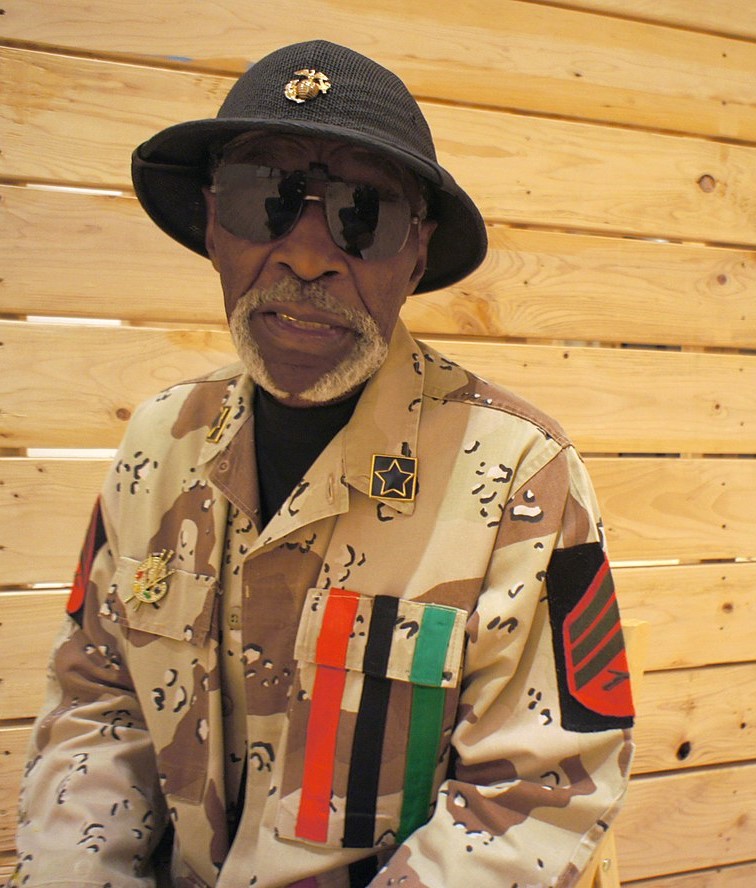Charles Smith, a visual artist, historian, activist, and minister, was born on November 11, 1940, to Bertha Mary Smith and an unnamed father in New Orleans, Louisiana. His early life was marked by tragedy when his father was killed in what local officials in New Orleans described as a ferry accident, but Smith believed it was a hate crime. This loss, however, did not deter him. He and his family moved to Chicago, Illinois, where, at the age of fourteen, he attended the funeral of Emmet Till, a fourteen-year-old African American boy from Chicago who was brutally murdered.
In 1966, Smith was drafted into the military and served two years as an infantryman in the Marines in South Vietnam until he was honorably discharged with a Purple Heart due to an injury he suffered in battle. Smith also suffered post-traumatic stress disorder (PTSD) as a result of the war. Despite this, he became an artist.
In 1985, Smith acquired a home in Aurora Township, Illinois. Over the next fourteen years, he transformed his home into an art environment where he built sculptures and monuments to memorialize moments in Black history and anti-Black racism. Smith used his own experiences in the Marine Corps during the Vietnam War and events in African American history, from slavery to the present, as his subject matter. He named his museum the African American Heritage Museum and Black Veteran’s Archive. The museum, at one point had 600 sculptures and 150 fixed pieces. In 1999, the Art Institute of Chicago named his museum a Millennium Site. The following year, the Kohler Foundation purchased 448 of his works.
In 2001, Smith relocated to Hammond, Louisiana, after finding a gravestone of Peter Hammond, who was later found to be the “Unnamed Slave Boy.” Smith established a second art museum there. The Hammond Museum included references to Egyptian architecture and ancient tombs. Smith’s work is also part of the collection of the John Micheal Kohler Art Center in Sheboygan, Wisconsin. In 2010, Smith’s work was included in Life, Liberty, and Pursuit of Happiness at the American Visionary Art Museum in Baltimore, Maryland. His work is also in the Smithsonian American Art Museum in Washington, D.C.
Smith lectured at the African American Men of Unity in Aurora, Illinois, in 2017 and at The Road Less Traveled conference in Sheboygan, Wisconsin. That same year, his work was auctioned at the New Orleans Botanical Garden benefit. His work was included in other events, including the Kohler Art Center’s 50th Anniversary exhibition series and Chicago Calling: Art Against the Flow.
In 2022, Smith had his first solo exhibition at White Columns, a New York City gallery. The exhibition featured twenty-nine new figurative sculptural works created for the gallery. The exhibit also featured photographic murals depicting items from the African American History Museum and Black Veterans Archive. Smith also has art sculptures that portray famous figures, including Phyllis Wheatley, Gordon Parks, Diana Ross, Iceberg Slim, and Paul Robeson. Smith is also an ordained minister at God’s House of Prayer and Holiness in Memphis, Tennessee. Smith remains an art historian as of 2024.
Do you find this information helpful? A small donation would help us keep this available to all. Forego a bottle of soda and donate its cost to us for the information you just learned, and feel good about helping to make it available to everyone.
BlackPast.org is a 501(c)(3) non-profit and our EIN is 26-1625373. Your donation is fully tax-deductible.
“Charles Smith,” Space Archives, https://spacesarchives.org/explore/search-the-online-collection/african-american-heritage-museum-and-black-veterans-archives/; “Charles Smith,” John Michael Kohler Arts Center, https://www.jmkac.org/artist/smith-dr-charles/ ; “Charles Smith,” Pelican Bomb, https://pelicanbomb.com/art-review/2017/site-specific-dr-charles-smith-and-the-archival-impulse.

